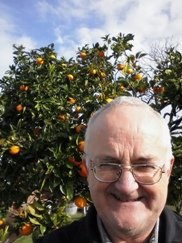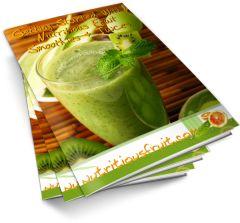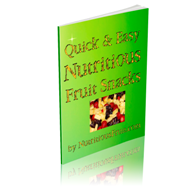Plantain: Origins - Consumption - Nutrition Facts - Health Benefits
|
|
|
Contents
- Geographic origin and regions grown
- History of consumption
- Common consumption today
- Nutrition Facts: Vitamins, minerals and phytochemical components
- Health Benefits: Medicinal uses based on scientific studies
- Bibliography
Geographic Origins and Regions Grown
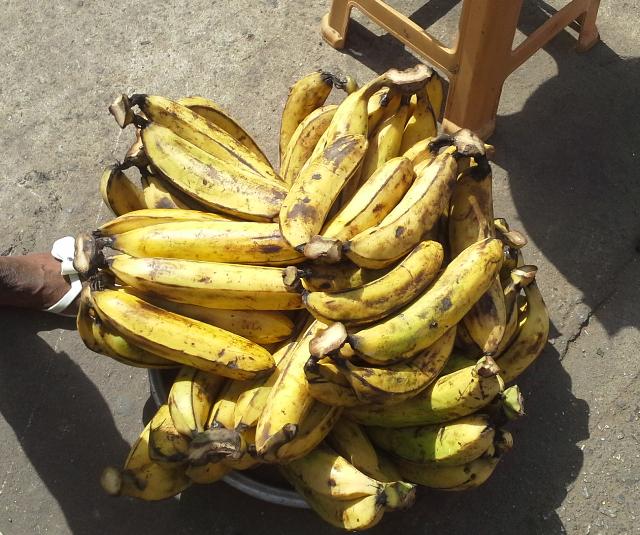
The plantain (pronounced plan-tane or plan-tin) is a species of the genus Musa and is generally used for cooking, in contrast to the soft, sweet banana, which is sometimes called the dessert banana. The occupants of North America were first to be introduced to the banana plantain. The term “banana” in the United States and Europe colloquially refer specifically to the banana variety and not plantain.
The word “banana” is often used incorrectly to describe other plantain varieties as well, when in fact the generic name is “plantain”. The correct terms for the various varieties of plantains include: banana plantain, cooking plantain, and bocadillo plantain. All members of the genus Musa are indigenous to the tropical region of Southeast Asia, including the Malay Archipelago and northern Australia.
Traditionally plantain leaves are used like plates for several dishes, such as Venezuelan Hallacas. They are also used while serving South Indian Thali or during sadhya. The leaves add a subtle but essential aroma to any dish. The leaves are for the most part widely available in grocery stores or open air markets in Venezuela and can exceed two meters in length.
They are also used to stimulate appetite as a fragrant smell is given off when hot food is placed on top of the leaf. In Nicaragua they are used to wrap their Nacatamales and for their Vigoron, Vaho, and other dishes. Vigoron is a dish that consists of tomatoes, onions, fried pork skin, and pickled cabbage served on plantain leaves.
In Honduras, Colombia, and several islands in the Caribbean, plantain leaves are usually used to wrap tamales before and while cooking. The leaves can also be used to wrap any kind of seasoned meat while cooking to keep the flavor in. In the Dominican Republic, the plantain is the country's main food source and is used just as much, if not more, than rice. Mangu and Sancocho are two signature dishes in the Dominican Republic that revolve around the plantain.
Plantain leaves resemble banana leaves, but they are larger, more durable, and reduce waste. The leaves are usually lightly smoked over an open fire and this adds to their toughness, their storage properties, and the flavor they give to meats and other foods. With plantain leaves there is a lot less disposal (pieces too small to use) in comparison to banana leaves, which makes plantain leaves a better choice.
The plantain will only fruit once during its season. After harvesting the fruit, the plantain plant can be cut and the layers peeled (like an onion) to get a cylinder shaped soft shoot. This can be chopped and first steamed, then fried with masala powder to make an excellent dish.
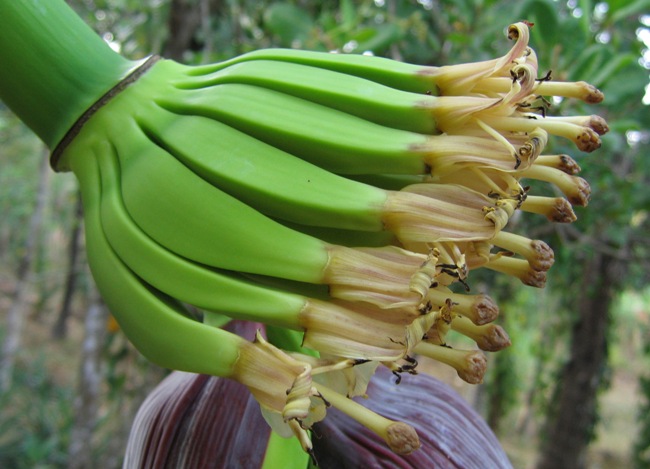
History of Consumption
Plantains tend to be firmer and lower in sugar content than dessert bananas and are used either when green or under ripe (and therefore starchy) or overripe (and therefore sweet). Plantains are a staple food in the tropical regions of the world, treated in much the same manner as potatoes, and have a similar neutral flavor and texture to potatoes when unripe.
They are grown as far north as Florida, the Caribbean, the Canary Islands, Madeira, Egypt, and southern Japan or Taiwan and as far south as KwaZulu-Natal and southern Brazil. The largest exporter of plantains to the United States is Colombia.
Several sources claim that plantains were introduced in the Caribbean and parts of the Americas by Portuguese Franciscan friars. The Spaniards, who saw a similarity to the plane tree that grows in Spain, gave the plantain its Spanish name, plátano.
Plantains will only flower once and all the flowers grow at the end of its shoot in separate bunches. Only the first few bunches will become fruits. Those that do not become fruit are used for cooking, and are often chopped and fried with masala powder. In Vietnam the flower is used in salads. In Cuisine of Laos, the banana flower is typically eaten raw in vermicelli soups.
The root stock which bears the leaves is soft and full of starch just before the flowering period and it is sometimes used as food source in Ethiopia. The young shoots of several species are normally cooked and eaten.
Common Consumption Today
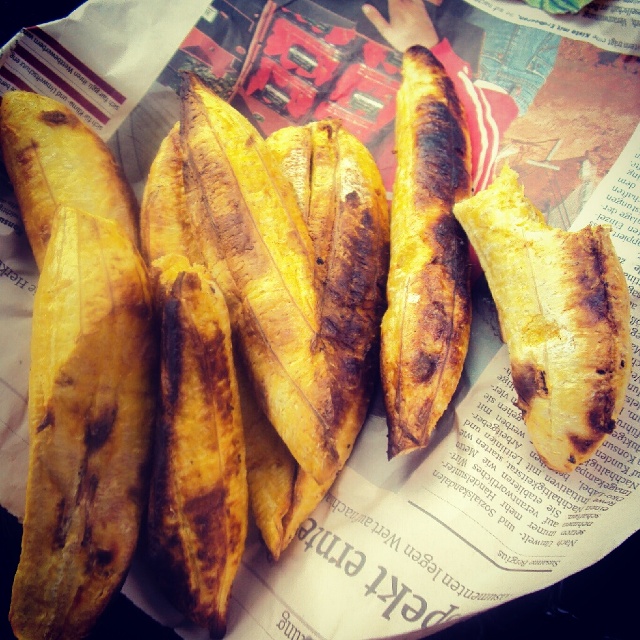
Plantains are usually baked or fried before eaten. Currently plantains are very popular in the Caribbean and various parts of Africa. Plantains can be used for cooking at any stage of ripeness and very ripe plantain can be eaten raw. As the plantain ripens, it becomes sweeter and its color changes from green to yellow to black, just like its cousin the banana. Green plantains are firm and starchy, and resemble potatoes in flavor. Yellow plantains are softer than green plantains, starchier, and sweeter.
The softest plantains are the ones that are extremely ripe because at this stage the deep yellow pulp is much sweeter. Due to this fact, sweet dishes usually consist of plantains that are turning from yellow to black. Plantains are often steamed as well, as they are considered to be very nutritious for infants and elderly in this form. Ripe plantain is used as food for infants during weaning. They are typically mashed with a pinch of salt and are believed to be more easily digestible than ripe bananas.
Nutrition Facts: Vitamins, Minerals and Phytochemical Components
Plantains are good sources of potassium and dietary fiber. They also contain vitamins A C, B2, and B6. The juice that excretes from peeling the plant can stain clothing and hands, and it can be very difficult to remove. Plantains are also dried and ground into flour.
Banana plantain meal is an important food source that has the following constituents: water 10.62%, albuminoids 3.55%, fat 1.15%, carbohydrates 81.67% (more than 2/3 starch), fiber 1.15%, phosphates 0.26%, 1.60% sugar, and other salts. The primary sugar is sucrose. Click the following link for full details.
Health Benefits: Medicinal Uses Based on Scientific Studies
Plantains are one of the most easily digestible fruits out there. It is also extremely rare for someone to be allergic to plantains. Plantains are a good source of vitamin C. In addition, plantains are known to have the highest potassium content of any common Western domestic market fruit.
They also have useful levels of riboflavin (B2) (2). One serving of plantain per day can provide a third of an adult’s recommended daily intake of pyridoxine (B6) (2). Plantain oils can reduce cholesterol in mice and thus can reduce the risk heart diseases (1).
Bibliography
1. Chung MJ, Woo Park K, Heon Kim K, Kim CT, Pill Baek J, Bang KH, Choi YM, Lee SJ. (2007). Asian plantain (Plantago asiatica) essential oils suppress 3-hydroxy-3-methyl-glutaryl-co-enzyme A reductase expression in vitro and in vivo and show hypocholesterolaemic properties in mice. British Journal of Nutrition, 15:1-9.
2. Personal Health Zone. (2007) Plantains Nutrition Information. Retrieved on December 11, 2007 from http://www.personalhealthzone.com/ nutrition/nutrients/fruits/ plantain.html
Disclaimer
Nutritiousfruit.com provides this website as a service. Although the information contained within the website is periodically updated, no guarantee is given that the information provided is correct, complete, and/or up-to-date. The materials contained on this website are provided for general information purposes only and do not constitute legal or other professional advice on any subject matter. Nutrtiousfruit.com does not accept any responsibility for any loss, which may arise from reliance on information contained on this website. The information and references in this website are intended solely for the general information for the reader. The content of this website are not intended to offer personal medical advice, diagnose health problems or to be used for treatment purposes. It is not a substitute for medical care provided by a licensed and qualified health professional. Please consult your health care provider for any advice on medications.
Didn't find what you were looking for? Search here...

Amazon Search Box:
Did you like this page?
|
|
|
